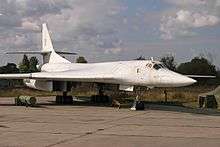Anti-flash white
Anti-flash white is a brilliant white color commonly seen on United States, British and Soviet nuclear bombers.[1] The purpose of the color was to reflect some of the thermal radiation from a nuclear explosion, protecting the aircraft and its occupants.
United Kingdom


Anti-flash white was used on the Royal Air Force V bombers force and the Royal Navy Blackburn Buccaneer when used in the nuclear strike role. British nuclear bombers were given – though not at first, until the problem was considered – pale pink and blue roundels and fin flash rather than the traditional dark red, white, and blue.
Anti-flash white was applied to several British prototype aircraft, including the British Aircraft Corporation TSR-2. Paint used on the British Avro Vulcan was manufactured by Cellon, and that on the Handley Page Victor by Titanine Ltd.[2]
United States

_and_GAM-72_Quail_decoy_missile_and_trailer_061127-F-1234S-010.jpg)
Many Strategic Air Command nuclear bombers carried anti-flash white without insignia on the under side of the fuselage with light silver-gray or natural metal (later light camouflage) on the upper surfaces.
The United States Navy A-5 Vigilante carried anti-flash white without insignia on the under side of the fuselage.
The Boeing E-6 in TACAMO role was painted anti-flash white but its roundels were not subdued.
Soviet Union/Russia/Ukraine


Like the United States, some nuclear bombers had the under side of the fuselage painted anti-flash white with the upper surfaces painted light silver-gray. This was true for the specially fitted, single Soviet Tu-95V bomber that test-deployed the most powerful bomb of any kind — the 50+ MT-rating Tsar Bomba on October 30, 1961 — as it had the anti-flash white on all its undersurfaces and sides.[3] The Tupolev Tu-160 of the 1980s was the first series-built Soviet/Russian bomber aircraft to be painted anti-flash white all over. leading to its Beliy Lebed "(White Swan)" Russian nickname.[4]
China
Some variants of the Xian H-6 had the under side of the fuselage painted anti-flash white.
Aircraft
In addition to these military aircraft, Concorde was painted white to reduce the additional heating effect on the aluminium skin caused by the sun whilst the aircraft was flying at high altitudes, the skin temperature already being raised to over 90 °C (194 °F) at Mach 2 by aerodynamic heating.
Aircraft with at least part of the fuselage painted anti-flash white on nuclear delivery variants:
- V bombers
- Blackburn Buccaneer
- English Electric Canberra (experimental)[5]
- BAC TSR-2 prototype
- Saunders-Roe SR.53 interceptor prototype
- Convair B-36
- Boeing B-47 Stratojet
- Boeing B-52 Stratofortress
- North American A-5 Vigilante
- North American XB-70 Valkyrie prototype
- Rockwell B-1 Lancer prototype
- CF-105 Arrow Prototypes
See also
- Royal Air Force roundels
- List of colors
- The House in the Middle - film that demonstrates the thermal flash protective effects of the related white wash paint
References
| Wikimedia Commons has media related to Anti-flash white. |
- Gunston, Bill (March 1981). "The V-Bombers - The Handley Page Victor - part 3". Aeroplane Monthly.
- ↑ "B36 in "anti-atom" finish over Kent" (PDF). Flight: 741. 11 November 1955.
- ↑ "Titanine aircraft finishes are used on the Handley-Page Victor". Flight: 1. 1 January 1954.
- ↑ "RDS 202: Tsar Bomb, The Biggest Bomb Ever". Youtube. 17 July 2009. Event occurs at 1:15 to 1:50. Retrieved 20 November 2015.
- ↑ "'White swan' – Russian supersonic aircraft". Moscow Top News. 2009. Archived from the original on 2 June 2009. Retrieved 19 July 2009.
- ↑ Philip J. R. Moyes (1964). Bomber Squadrons of the R.A.F. And Their Aircraft. MacDonald. p. 98.
